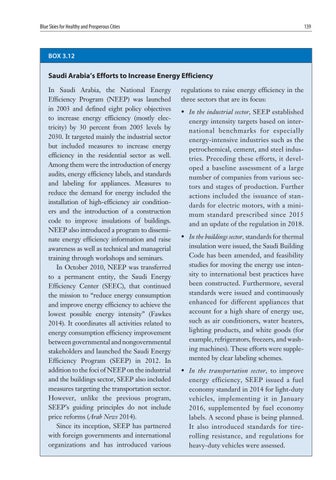Blue Skies for Healthy and Prosperous Cities
139
BOX 3.12
Saudi Arabia’s Efforts to Increase Energy Efficiency In Saudi Arabia, the National Energy Efficiency Program (NEEP) was launched in 2003 and defined eight policy objectives to increase energy efficiency (mostly electricity) by 30 percent from 2005 levels by 2030. It targeted mainly the industrial sector but included measures to increase energy efficiency in the residential sector as well. Among them were the introduction of energy audits, energy efficiency labels, and standards and labeling for appliances. Measures to reduce the demand for energy included the installation of high-efficiency air conditioners and the introduction of a construction code to improve insulations of buildings. NEEP also introduced a program to disseminate energy efficiency information and raise awareness as well as technical and managerial training through workshops and seminars. In October 2010, NEEP was transferred to a permanent entity, the Saudi Energy Efficiency Center (SEEC), that continued the mission to “reduce energy consumption and improve energy efficiency to achieve the lowest possible energy intensity” (Fawkes 2014). It coordinates all activities related to energy consumption efficiency improvement between governmental and nongovernmental stakeholders and launched the Saudi Energy Efficiency Program (SEEP) in 2012. In addition to the foci of NEEP on the industrial and the buildings sector, SEEP also included measures targeting the transportation sector. However, unlike the previous program, SEEP’s guiding principles do not include price reforms (Arab News 2014). Since its inception, SEEP has partnered with foreign governments and international organizations and has introduced various
regulations to raise energy efficiency in the three sectors that are its focus: • In the industrial sector, SEEP established energy intensity targets based on international benchmarks for especially energy-intensive industries such as the petrochemical, cement, and steel industries. Preceding these efforts, it developed a baseline assessment of a large number of companies from various sectors and stages of production. Further actions included the issuance of standards for electric motors, with a minimum standard prescribed since 2015 and an update of the regulation in 2018. • In the buildings sector, standards for thermal insulation were issued, the Saudi Building Code has been amended, and feasibility studies for moving the energy use intensity to international best practices have been constructed. Furthermore, several standards were issued and continuously enhanced for different appliances that account for a high share of energy use, such as air conditioners, water heaters, lighting products, and white goods (for example, refrigerators, freezers, and washing machines). These efforts were supplemented by clear labeling schemes. • In the transportation sector, to improve energy efficiency, SEEP issued a fuel economy standard in 2014 for light-duty vehicles, implementing it in January 2016, supplemented by fuel economy labels. A second phase is being planned. It also introduced standards for tire- rolling resistance, and regulations for heavy-duty vehicles were assessed.






